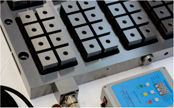Alnico magnets were the strongest permanent magnets that existed until the introduction of rare earth magnets and, although somewhat displaced, Alnico magnets are still commonly used in various industries for specific jobs such as high temperature handling equipment and sensor manufacturing, among others. Alnico magnets have long life, excellent temperature stability, high residual induction and relatively high energies due to their composition, a combination of aluminium (al), nickel (ni) and cobalt (co).
This development and introduction of Alnico meant that expensive electromagnets could be replaced with these permanent magnets in essential devices such as motors and generators. But despite not having the prominence of years ago, Alnico magnets still perform better than their successors in specific situations and, therefore, are still used for many applications that require a very high temperature concentration such as;

Railways

Electric Guitar Pickups

Speaker

Electrical Instruments

Magnetic Level Indicator

Sensors

Magnetic Flow Meter

Robots

Military Machinery

Aerospace Machinery

Automobile Industry

EPM Assemblies
In addition, Alnico magnets are widely used in rotary machinery, meters, instruments, detection devices and retention applications, to name a few. It should be noted that Alnico is hard and brittle. Therefore, machining or drilling cannot be done by ordinary methods. Holes are usually drilled in the foundry, magnets are molded near the final size and then machined to closer tolerances. Likewise, Alnico magnets have high magnetic resistance and low resistance to demagnetization and remagnetization.
Their uses are based on their strength
Unlike, for example, ferrite magnets, Alnico magnets are generally stronger and are electrically conductive, while they are less fragile than most rare earth magnets and can produce a strong magnetic field. In addition, Alnico magnets can operate at the highest temperatures of any magnetic material and maintain their magnetism even when they are red-hot. How is this possible? Because of its composition. Alnico magnets are manufactured by casting or sintering processes. Under the first mode of manufacture, a molten metal alloy is poured into a mold and then passed through several heat cycles. The final product is a magnet with a dark grey exterior, with a rough surface, but the machined magnet surfaces have a glossy appearance.






